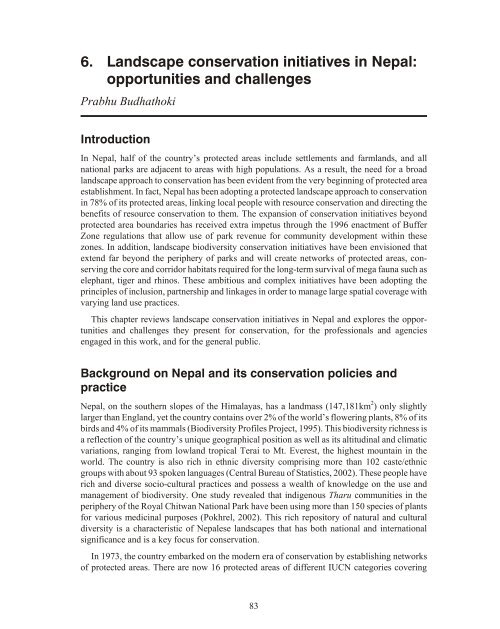The Protected Landscape Approach - Centre for Mediterranean ...
The Protected Landscape Approach - Centre for Mediterranean ...
The Protected Landscape Approach - Centre for Mediterranean ...
You also want an ePaper? Increase the reach of your titles
YUMPU automatically turns print PDFs into web optimized ePapers that Google loves.
6. <strong>Landscape</strong> conservation initiatives in Nepal:<br />
opportunities and challenges<br />
Prabhu Budhathoki<br />
Introduction<br />
In Nepal, half of the country’s protected areas include settlements and farmlands, and all<br />
national parks are adjacent to areas with high populations. As a result, the need <strong>for</strong> a broad<br />
landscape approach to conservation has been evident from the very beginning of protected area<br />
establishment. In fact, Nepal has been adopting a protected landscape approach to conservation<br />
in 78% of its protected areas, linking local people with resource conservation and directing the<br />
benefits of resource conservation to them. <strong>The</strong> expansion of conservation initiatives beyond<br />
protected area boundaries has received extra impetus through the 1996 enactment of Buffer<br />
Zone regulations that allow use of park revenue <strong>for</strong> community development within these<br />
zones. In addition, landscape biodiversity conservation initiatives have been envisioned that<br />
extend far beyond the periphery of parks and will create networks of protected areas, con -<br />
serving the core and corridor habitats required <strong>for</strong> the long-term survival of mega fauna such as<br />
elephant, tiger and rhinos. <strong>The</strong>se ambitious and complex initiatives have been adopting the<br />
principles of inclusion, partnership and linkages in order to manage large spatial coverage with<br />
varying land use practices.<br />
This chapter reviews landscape conservation initiatives in Nepal and explores the oppor -<br />
tunities and challenges they present <strong>for</strong> conservation, <strong>for</strong> the professionals and agencies<br />
engaged in this work, and <strong>for</strong> the general public.<br />
Background on Nepal and its conservation policies and<br />
practice<br />
Nepal, on the southern slopes of the Himalayas, has a landmass (147,181km 2 ) only slightly<br />
larger than England, yet the country contains over 2% of the world’s flowering plants, 8% of its<br />
birds and 4% of its mammals (Biodiversity Profiles Project, 1995). This biodiversity richness is<br />
a reflection of the country’s unique geographical position as well as its altitudinal and climatic<br />
variations, ranging from lowland tropical Terai to Mt. Everest, the highest mountain in the<br />
world. <strong>The</strong> country is also rich in ethnic diversity comprising more than 102 caste/ethnic<br />
groups with about 93 spoken languages (Central Bureau of Statistics, 2002). <strong>The</strong>se people have<br />
rich and diverse socio-cultural practices and possess a wealth of knowledge on the use and<br />
management of biodiversity. One study revealed that indigenous Tharu communities in the<br />
periphery of the Royal Chitwan National Park have been using more than 150 species of plants<br />
<strong>for</strong> various medicinal purposes (Pokhrel, 2002). This rich repository of natural and cultural<br />
diversity is a characteristic of Nepalese landscapes that has both national and international<br />
significance and is a key focus <strong>for</strong> conservation.<br />
In 1973, the country embarked on the modern era of conservation by establishing networks<br />
of protected areas. <strong>The</strong>re are now 16 protected areas of different IUCN categories covering<br />
83

















